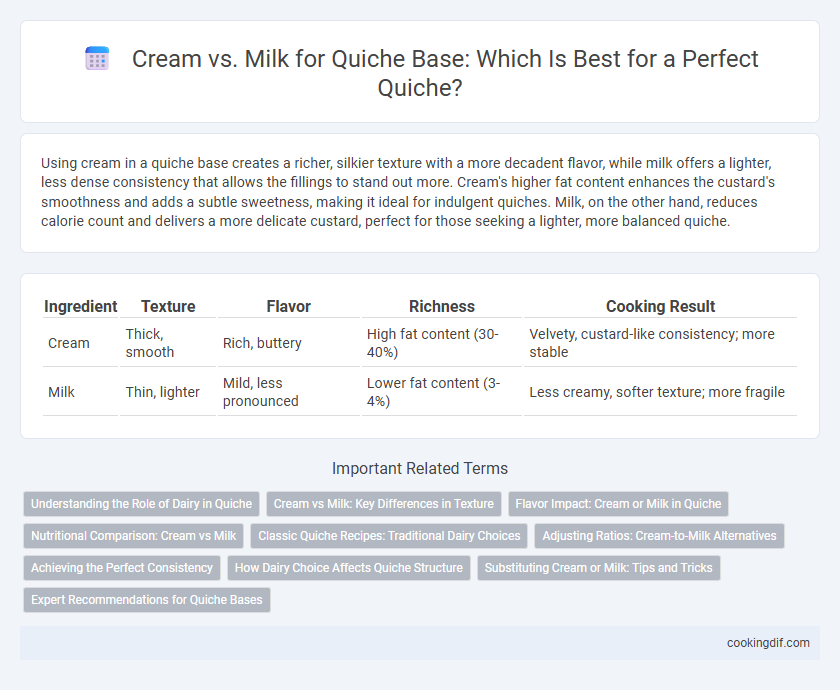Using cream in a quiche base creates a richer, silkier texture with a more decadent flavor, while milk offers a lighter, less dense consistency that allows the fillings to stand out more. Cream's higher fat content enhances the custard's smoothness and adds a subtle sweetness, making it ideal for indulgent quiches. Milk, on the other hand, reduces calorie count and delivers a more delicate custard, perfect for those seeking a lighter, more balanced quiche.
Table of Comparison
| Ingredient | Texture | Flavor | Richness | Cooking Result |
|---|---|---|---|---|
| Cream | Thick, smooth | Rich, buttery | High fat content (30-40%) | Velvety, custard-like consistency; more stable |
| Milk | Thin, lighter | Mild, less pronounced | Lower fat content (3-4%) | Less creamy, softer texture; more fragile |
Understanding the Role of Dairy in Quiche
Cream provides quiche with a rich, velvety texture and enhances the custard's creaminess, while milk offers a lighter consistency that results in a more delicate bite. The fat content in cream contributes to a tender, silky quiche filling by emulsifying the egg mixture and preventing curdling during baking. Choosing the right dairy--heavy cream for indulgence or milk for lightness--directly impacts the flavor profile and mouthfeel of a perfectly balanced quiche.
Cream vs Milk: Key Differences in Texture
Cream produces a richer, silkier texture in quiche due to its higher fat content, which enhances the custard's smoothness and mouthfeel. Milk yields a lighter, more delicate filling with a less dense consistency, allowing the other ingredients to stand out more prominently. Choosing between cream and milk directly influences the quiche's overall texture, balancing richness with firmness depending on the desired outcome.
Flavor Impact: Cream or Milk in Quiche
Using cream in a quiche base enriches the texture and enhances the flavor with a luxurious, velvety mouthfeel due to its higher fat content. Milk produces a lighter, more delicate custard, allowing the natural taste of ingredients like cheese and vegetables to shine through. Choosing cream results in a richer, more indulgent quiche, while milk offers a subtler, less heavy flavor profile.
Nutritional Comparison: Cream vs Milk
Cream contains higher fat content and calories compared to milk, making it richer and providing a denser texture for quiche bases. Milk contributes fewer calories and less fat while offering essential nutrients like calcium and vitamin D, resulting in a lighter, less creamy quiche. Choosing between cream and milk influences not only flavor and texture but also the nutritional profile, impacting calorie intake and fat consumption.
Classic Quiche Recipes: Traditional Dairy Choices
Classic quiche recipes traditionally use heavy cream or a combination of cream and milk to achieve a rich and creamy custard base, enhancing texture and flavor. Heavy cream provides a smooth, luscious consistency with higher fat content, while milk offers a lighter alternative, resulting in a more delicate quiche. Using cream alone or blended with milk balances richness and tenderness, essential for authentic quiche Lorraine and similar traditional variations.
Adjusting Ratios: Cream-to-Milk Alternatives
Adjusting the cream-to-milk ratio in a quiche base directly impacts the texture and richness, with higher cream content yielding a custard-like, velvety consistency, while increased milk produces a lighter, more delicate structure. Common ratios range from a 1:1 blend to as much as 2:1 cream to milk, allowing for customization based on desired creaminess and calorie preference. Substituting half-and-half or whole milk for heavy cream can reduce fat content while maintaining a creamy mouthfeel, important for achieving the ideal quiche custard balance.
Achieving the Perfect Consistency
Using heavy cream in a quiche base creates a rich, velvety texture due to its higher fat content, which enhances the custard's smoothness and firmness. Milk produces a lighter, more delicate filling but may result in a less stable consistency that can be slightly runnier after baking. Balancing cream and milk allows for precise control over the quiche's texture, achieving the ideal creamy yet set custard that holds its shape well.
How Dairy Choice Affects Quiche Structure
Using cream in a quiche base results in a richer, denser texture due to its higher fat content, which helps create a custard that sets firmly yet remains smooth. Milk, being lower in fat, produces a lighter, more tender quiche with a slightly softer structure that may be less stable when sliced. The choice between cream and milk directly influences moisture retention and firmness, impacting both the mouthfeel and the overall presentation of the quiche.
Substituting Cream or Milk: Tips and Tricks
Substituting cream or milk in a quiche base affects texture and richness; cream provides a custard-like, velvety consistency while milk yields a lighter, less rich filling. For a balanced substitution, use whole milk with a tablespoon of melted butter per cup to mimic cream's fat content, ensuring a smooth and tender quiche. Adjust baking time slightly when using milk, as lower fat content can increase the risk of a runny center, so monitor doneness carefully for perfect results.
Expert Recommendations for Quiche Bases
Experts recommend using heavy cream over milk for quiche bases due to its higher fat content, which creates a richer, creamier texture and enhances the overall flavor. Milk can be used for a lighter quiche but may result in a less custardy and slightly watery consistency. Professional chefs often balance cream with milk or half-and-half to achieve a custard that is silky yet stable during baking.
cream vs milk for quiche base Infographic

 cookingdif.com
cookingdif.com